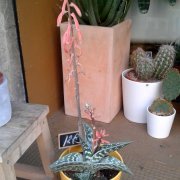Care of the succulent plant Aloe variegata or Tiger aloe |
|
The genus Aloe is included in the subfamily Asphodeloideae (family Xanthorrhoeaceae), which comprises about 500 species of succulent plants native to Africa, Madagascar and the Middle East. Some species are: Aloe variegata, Aloe x caesia, Aloe pluridens, Aloe thraskii, Aloe tenuior, Aloe suprafoliata, Aloe striata, Aloe plicatilis, Aloe mitriformis, Aloe marlothii, Aloe maculata, Aloe juvenna, Aloe ferox, Aloe x delaetii, Aloe ciliaris, Aloe barberae, Aloe aristata, Aloe arborescens, Aloe aculeata, Aloe vera, Aloe x spinosissima, Aloe esculenta. Common names: Tiger aloe, Partridge-breasted aloe. This species is native to South Africa and Namibia. They are small succulent plants that are easy to grow, without a stem or with a very short one, reaching 30 cm (11.8") in height. The interesting fleshy and lanceolate leaves appear in a rosette, they are dark green with transverse bands and a white border with small teeth. The flowers appear in branched inflorescences, they are red or pink and tubular in shape. They bloom in the second half of winter. Tiger aloe is used in pots as a houseplant or for balconies and terraces and also in rockeries and cactus and succulent gardens in regions with a subtropical climate. Aloe variegata needs a semi-shade exposure, avoiding direct sunlight in the middle of the day. It prefers heat and a dry atmosphere. The winter temperature should not drop below 10 ºC (50 ºF). The soil has to be very well drained and contain organic matter; for example a commercial substrate for cacti and succulents. Water moderately in spring and summer, waiting for the soil to dry. In autumn, reduce watering until winter is occasional. It is important not to wet the rosette. Fertilize in the fall with compost and twice with mineral cactus fertilizer in the spring and summer. Partridge-breasted aloe does not need pruning but wilted inflorescences can be removed. Tiger aloe is very sensitive to excess moisture that quickly rots the plant; sometimes it can be victims of mealybugs. The simplest form of propagation is from the shoots that the plant produces at the base (they must have a root). |
Image of the succulent plant Aloe variegata or Tiger aloe |
Find plants
Aloe variegata or Tiger aloe | Care and Growing
© 2025 FavThemes



